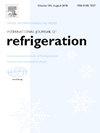以转子深度为重点的螺杆压缩机设计优化:计算流体动力学方法
IF 3.5
2区 工程技术
Q1 ENGINEERING, MECHANICAL
International Journal of Refrigeration-revue Internationale Du Froid
Pub Date : 2025-02-01
DOI:10.1016/j.ijrefrig.2024.12.001
引用次数: 0
摘要
对提高双螺杆压缩机性能和可靠性的需求日益增长,需要应用先进的优化工具来提高性能。本研究采用响应面法(RSM)来优化标准5/6压缩机的外形参数,具体目标是降低比功率。优化过程中考虑了转子轴距、内转子外径等决定转子深度的关键因素。随着转子轮廓的优化,端口优化也使用相同的方法进行。使用SCORG™软件进行多室热力学分析,可以计算几何值和热力学量。转子优化的结果显示出显著的改进:比功率降低4.30%,容积效率提高2.73%,绝热效率提高3.93%,容积流量与参考设计相比提高2.88%。在端口优化后,优化转子剖面的体积和绝热效率保持相当,而比功率进一步降低了1.37%。为了验证优化后的压缩机的性能,使用SCORG™和ANSYS CFX多相求解器生成的保形网格进行了计算流体动力学(CFD)分析。SCORG™和CFD的最佳结果之间的最大偏差仅为0.19%,表明两种方法之间的一致性很强。本研究强调了优化技术对双螺杆压缩机性能的重要影响。本文章由计算机程序翻译,如有差异,请以英文原文为准。
Design optimisation of a screw compressor with a focus on rotor depth: A computational fluid dynamics approach
The increasing demand for enhanced performance and reliability in twin-screw compressors necessitates the application of advanced optimisation tools to improve performance. This study employs response surface methodology (RSM) to optimise the profile parameters of a standard 5/6 compressor, specifically targeting reduction in specific power. Key factors such as axis distance between rotors and female rotor outer diameter, which define the rotor depth, were included in the present optimisation process.
Following the optimisation of the rotor profile, port optimisation was also conducted using the same methodology. A multi-chamber thermodynamic analysis was performed with SCORG™ software, which allowed for the calculation of geometric values and thermodynamic quantities. The results of the rotor optimisation revealed notable improvements: a 4.30 % reduction in specific power, a 2.73 % increase in volumetric efficiency, a 3.93 % enhancement in adiabatic efficiency, and a 2.88 % rise in volumetric flow rate compared to the reference design. After port optimisation, both volumetric and adiabatic efficiencies of the optimised rotor profile remained comparable, while specific power was further reduced by 1.37 %.
To validate the performance of the optimised compressor, computational fluid dynamics (CFD) analysis was conducted using a conformal mesh generated by SCORG™ and ANSYS CFX multiphase solver. The maximum deviation between the optimal results from SCORG™ and CFD was only 0.19 %, indicating strong agreement between the two methodologies. This study highlights the significant impact of optimisation techniques on the performance of twin-screw compressors.
求助全文
通过发布文献求助,成功后即可免费获取论文全文。
去求助
来源期刊
CiteScore
7.30
自引率
12.80%
发文量
363
审稿时长
3.7 months
期刊介绍:
The International Journal of Refrigeration is published for the International Institute of Refrigeration (IIR) by Elsevier. It is essential reading for all those wishing to keep abreast of research and industrial news in refrigeration, air conditioning and associated fields. This is particularly important in these times of rapid introduction of alternative refrigerants and the emergence of new technology. The journal has published special issues on alternative refrigerants and novel topics in the field of boiling, condensation, heat pumps, food refrigeration, carbon dioxide, ammonia, hydrocarbons, magnetic refrigeration at room temperature, sorptive cooling, phase change materials and slurries, ejector technology, compressors, and solar cooling.
As well as original research papers the International Journal of Refrigeration also includes review articles, papers presented at IIR conferences, short reports and letters describing preliminary results and experimental details, and letters to the Editor on recent areas of discussion and controversy. Other features include forthcoming events, conference reports and book reviews.
Papers are published in either English or French with the IIR news section in both languages.

 求助内容:
求助内容: 应助结果提醒方式:
应助结果提醒方式:


